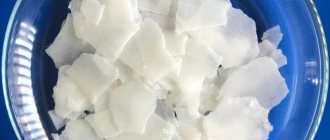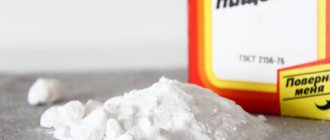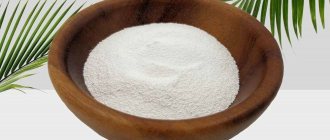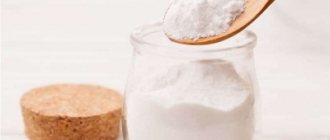Many people have experienced clogs in their sewer pipes. More often, a paid service is called to clean it. Wasting money can be avoided because there are methods for cleaning sewer drains yourself. For example, it is common to use caustic soda to clean sewers. This is a caustic substance with which you can independently remove any blockage.
Weighing Caustic Soda
What is caustic soda?
Caustic soda is primarily an alkali that can corrode organic matter, while it is an excellent stain remover. Compared to baking soda and soda ash, caustic soda has a greater cleaning effect. Caustic soda is produced in the form of a powder, in which you can see small crystals and flakes, painted white. In addition, the powder does not have any odor, and the size of the grains does not exceed 1-1.5 mm.
Compound
Caustic soda consists of oxygen, sodium and hydrogen molecules, as evidenced by the structural formula of the substance NaOH. It will not be possible to find caustic soda in its pure form; it is obtained industrially from a solution of table salt. At the same time, the norm for caustic soda is considered to be no less than 98.5%. Caustic is produced both solid and in liquid form. Transported in bags or special containers.
Solid caustic, when dissolved in water, is capable of generating heat. You should use caustic with caution, as caustic soda can be harmful to health if safety rules are not followed.
Operating principle
The principle of action of caustic soda is that when it comes into contact with fatty deposits, it dissolves the fat, and if you use it when cleaning sewers, it can easily cope with organic substances that accumulate on the walls of pipes.
If caustic soda is poured into the clogged area, it will soften it, and the problem will be solved in a short period of time. After peeling off the resulting blockage and exposure to the substance, it is washed with water, pushing the blockage further along the pipe opening.
Are caustic soda and soda ash the same thing?
Caustic and soda ash are two different substances, but they are united by their alkaline origin and base. The main difference between one soda and another is its chemical composition, as well as its effectiveness. It is known that soda ash is not very effective in dealing with blockages in the sewer; when using it, there will be practically no effect. Caustic soda can deal with this problem in an instant.
Caustic soda is an alkali, and soda ash is practically the same baking soda that many people use for baking and at home.
When should you clean your septic tank?
A cesspool, if it is created using the right technology and is systematically maintained, can last quite a long time. There are signs that indicate it's time to clean the container.
The main ones are:
- the appearance of a persistent unpleasant odor;
- formation of silt at the bottom of the pit;
- rapid overflow of the container;
- Strong factions settle on the walls, which are almost impossible to get rid of.
If one or more of these signs are present, then immediate cleaning should be done. Many owners claim that if the septic tank is very dirty, caustic soda will not help, but one of the modern biological agents will. Nowadays there are quite a lot of them on sale, you can choose exactly the one that is completely suitable.
Recommended for you:
How to get rid of fleas with soda: in an apartment, house, country house
What is caustic soda used for in everyday life?
In agriculture
In agriculture, caustic soda is used to disinfect premises where livestock are kept. At the same time, not only the territories are processed, but also all equipment.
Removing scale and deposits from dishes
Caustic does an excellent job of removing scale and deposits that form on dishes. You can do this as follows:
- To 10 liters of water, add 200 g. caustic.
- Grind 20 gr. laundry soap and add to the soda solution.
- Mix thoroughly until the ingredients are completely dissolved.
- Add 150 ml of office glue to the dishes that you plan to clean.
- Stir, put on fire and bring to a boil.
- It is recommended to boil dishes with scale and carbon deposits in this solution for 1–2 hours.
- Remove the dishes from the solution and wash with detergent.
- Rinse in running water.
This method is suitable for cookware made of enamel, cast iron and steel. It is under no circumstances recommended to clean Teflon coatings and aluminum utensils with caustic soda.
Making homemade soaps and detergents
You can use caustic soda to make homemade soap or cleaner. Recipe:
- In 150 gr. distilled water, brought to a boil, dilute 70 g. purified caustic soda.
- Flaxseed, sea buckthorn or almond oil, 0.5 kg is enough, heat in a water bath.
- Add it to the soda solution.
- To stir thoroughly.
- Pour into prepared pans.
- Keep in a dry place for several days, then remove the finished soap.
Removing blockages, cleaning drains
Some housewives clean sewers using caustic soda for a private home. This method effectively copes with any blockages.
- In a 4-liter container with cold water, add 200 g. caustic.
- To stir thoroughly.
- Pour it down the drain.
- Do not use the toilet for 1–2 hours, as the water from the flush can wash away the caustic soda and there will be no positive effect.
- After this time, rinse with 15 liters of hot water and pour it into the drain.
Cesspool cleaning
When cleaning cesspools, the proportions of substances depend directly on its size and depth.
For the procedure you will need:
- Protective gloves.
- Shovel.
- Bucket.
- Respirator.
The procedure is carried out as follows:
- 3-4 kg of caustic soda is poured into a bucket.
- Pour in 5–7 liters of water.
- Mix thoroughly.
- Pour into the cesspool.
- The procedure is carried out until the pit is completely cleared.
For disinfection
Caustic is also used for disinfection during wet cleaning.
Reviews
Irina, 22 years old: “I live alone. When at night I saw that the water in the sink was not draining, I was terribly scared, because there was no special product in the house, so I decided to fix the problem with soda and vinegar. First, I poured the powder directly into the sink, did not remove the water, then poured in the vinegar. Literally half an hour later the water began to gradually go away. When the sink became dry, I repeated the procedure, only I poured in the food and poured it into the drain. The method is really effective. I repeat the procedure every month. This never happened again."
Christina, 34 years old: “I always monitored the condition of the sewage system, once a month I washed it with different products for prevention, but it didn’t help. A neighbor had been talking about baking soda and vinegar for a long time, and with particular delight. I decided to try it too. These food products seem to actually work. And they are much cheaper than industrial products.”
Caustic soda in other areas
Caustic soda is used in many applications. For example, in veterinary medicine I use it to disinfect animal premises; in addition, it is used in the food, textile, pulp and paper, chemical and automotive industries. Let's take a closer look.
Use in veterinary medicine
Caustic soda is used to disinfect premises where livestock are kept. Veterinarians recommend treating these areas daily with a concentrated caustic solution. The permissible dosage of caustic soda concentration is 1%, and if animals have infectious diseases, it is increased to 10%.
Industrial Applications
In industry, caustic is used in the following industries:
- Based on it, the food additive E-524 is prepared, which is subsequently used for the preparation of chocolate products, ice cream and various drinks.
- In the production of silk products and for bleaching fabrics.
- They produce paper and cardboard.
- Manufacture of detergents.
- In the production of car batteries and fuel.
Health Hazard
Let's look at this procedure from the perspective of our health. When using vinegar, you need to be quite careful, we are taught this from childhood. I strongly recommend not to use, and generally not to handle, 70% vinegar essence, as this is indeed a very dangerous substance.
For example, if used incorrectly and if safety precautions are ignored, it can cause numerous chemical burns of the skin, damage to the respiratory tract and mucous membranes, swelling of the esophagus, vomiting with blood appears, with a severe burn, tissue cell death is observed, and ulcers are formed accordingly, it can also change blood composition, kidney function will be impaired.
Before using this powerful chemical element, you must take precautions. Firstly, it is better to work in thick rubber gloves and long sleeves, so that in an unfavorable case the acid gets on the clothes and not on the skin.
Vinegar essence cannot be tasted or even smelled. It is necessary to use goggles and a carbon respirator to protect against fumes.
Advantages and disadvantages
Caustic soda has both advantages and disadvantages.
Advantages:
- Quickly and effectively copes with organic contaminants.
- Has a simple application for cleaning drains.
- Completely soluble in water.
- It is not capable of harming plastic, cast iron, rubber and other materials used in sewerage parts.
- Quite a low price for the substance.
Flaws:
- Caustic soda is a substance that has a strong effect and quite high toxicity.
- Affects only organic substances.
- Has a negative effect upon contact with galvanized, aluminum and enamel coating.
- The substance should be stored only in closed form.
- Short shelf life, only 12 months.
Effective chemicals for dissolving grease in pits
Caustic soda for septic tanks is not the only chemical that can break down grease particles and clean out the contaminants created by sewage.
In practice, other substances with different effects on pollution are also used:
- Formaldehyde. It is quite effective in cleaning matters, but has a detrimental effect on further filtration of wastewater. It destroys beneficial microorganisms, stopping their biological activity. It is undesirable to use in close proximity to groundwater.
- Bleaching powder. Eliminates unpleasant odors caused by stagnant wastewater. Breaks down solid particles. Has a negative effect on microflora.
- Ammonium compounds. They are used as an accelerator of the decomposition process and eliminate odor from the sump. Minus - they do not affect household chemicals in drains.
- Nitrate oxidizers. They are used for the production of fertilizers, therefore they do not have a destructive effect on microflora. Neutralizes odors and traces of household chemicals in drains. The cost is significantly higher than caustic soda.
How to use soda to get rid of blockages?
Using soda to deal with clogs is quite simple, the main thing is to follow the instructions. And they do it like this:
- Pour 150 grams into the drain. caustic soda.
- Pour 2 liters of boiling water.
- Leave for 15–20 minutes.
- After this, add another 2 liters of hot water.
- Do not use the bathroom for an hour.
- Rinse the drain with 15–20 liters of water.
Cleaning with solution
To combat the blockage, it is necessary to properly prepare the solution. And you can do it like this:
- Add 2-3 kg of caustic to 8 liters of water.
- Mix thoroughly until the granules are completely dissolved.
- Slowly pour half the solution down the drain.
- After a few hours, pour out the rest.
- Flush the drain with plenty of running water.
Powder cleaning
To combat blockages using caustic soda powder, simply pour a small amount of the substance into the toilet bowl and add plenty of water. This must be done with caution, as this method can damage the sewer pipes and this can lead to leakage. Therefore, experts recommend using a small amount of the active substance and then caustic soda will do an excellent job not only with the blockage, but also corrode all the organic matter deposited on the walls of the pipes.
Gel cleaning
Clearing the blockage using a gel based on caustic soda is a less safe method, unlike the previous option. To clean, you need to mix 100 ml of gel with 250 ml of boiling water, mix thoroughly and pour into the sewer hole. Leave for several hours, then rinse with plenty of running water.
Is it possible to clean plastic pipes with caustic soda?
Cleaning plastic pipes with caustic soda is highly not recommended. It should be remembered that this substance is an alkali and may well harm the plastic product. It is better to figure out the reason why the blockage occurs periodically or use more gentle means.
Septic tank cleaning
In apartments and houses, in cities where there is a stationary sewer system, caustic soda is widely used as a pipe cleaner. This process is simple, it can be done on your own without the participation of specialists.
Expert opinion
We recommend!
In suburban housing, there is not always a sewerage system, so the owners get out of the situation by equipping a septic tank for wastewater. This design is somewhat simpler than a sewer, but it also requires regular maintenance and cleaning. Caustic is also suitable for these purposes.
Once a year, you should invite sewage specialists to clean and restore the drainage pit. And in the intervals between these works, you can independently care for the septic tank using soda. Caustic is suitable for cleaning if the container is completely sealed or has good ventilation. It is also good if the septic tank is located in the far corner of the land, away from where people live.
Expert opinion
Attention!
Note! Ideally, it is necessary that on the day of cleaning the container and for several days after it, no one else will be nearby.
How to flush a radiator with caustic soda?
You can only flush the radiator with caustic soda if it is made of cast iron or chrome-nickel steel. It is prohibited to use this method for radiators made of aluminum, iron, tin, zinc or lead, since when interacting with this metal, the caustic becomes an explosive substance.
Radiator flushing method:
- Flush the radiator in the summer, after turning off the heating completely.
- To do this, use a pump to pump a 15% caustic soda solution into the radiator.
- Leave the substance inside the heating device for 2–3 days.
- Drain the solution and wash with plenty of water.
Other drain cleaning methods
Above we looked at cleaning methods that involve a mixture of vinegar and soda. However, there are other techniques that involve adding other ingredients:
- Vinegar can be replaced with 100-150 g of regular salt mixed with 200-500 g of baking soda and boiling water. The resulting mixture is poured down the drain and another 1.5 liters of boiling water is poured. The composition is kept in the pipe for about 8-10 hours, and then thoroughly poured.
- Crystallized tartar can be added to the previous composition. Ratio: baking soda and table salt 1 cup each, cream of tartar - ¼ cup. All ingredients are pre-mixed and then poured into the drain. For 1 hour, add boiling water every 10-15 minutes, and at the end, pour cool water over the system.
- Vinegar can be replaced with a packet of classic citric acid, which is diluted in 1 tbsp. warm water. This amount is enough for 250 g of baking soda.
How to fertilize garden trees with caustic soda?
Many gardeners treat garden trees with caustic soda in order to save them from diseases such as late blight, powdery mildew, black spot, and various fungi. This method differs from others in that it is quite cheap and effectively copes with the disease, increasing the abundance of the crop.
To treat trees and shrubs, you need to mix 10 liters of water and 5-6 tbsp. l. caustic, mix and water the plants. Greenhouses are also treated with this solution for disinfection before planting seedlings.
How to clean dishes with caustic soda?
To clean the dishes, you need to do the following:
- Pour water into the contaminated container.
- For every 10 liters, you will need 200 grams. caustic.
- Add laundry soap, grated on a fine grater.
- Pour in 150 gr. office glue.
- Carefully move the solution.
- Place on fire and bring to a boil.
- Cook for 1.5-2 hours.
- Pour the solution into the sink.
- Wash dishes with detergent.
- Rinse thoroughly in running water.
This method is used for pots, pans and plates. The main thing to remember is that after the solution boils, it is recommended to keep the dishes in it for no more than 20 minutes.
Features of application
There are several universal rules when using soda:
- To carry out the procedure, it is important to remember about protective equipment: it is better to wear rubber gloves and a gauze bandage.
- Before starting the procedure, ensure good air ventilation: open a window or vent.
- Do not use baking soda on plastic pipes.
- Monitor the activity time of the soda: no more than 5-6 hours.
- Upon completion of the procedure, be sure to flush the sewer system with strong pressure of cold running water.
Safety regulations
When using caustic soda, the following safety precautions must be observed:
- Use a respirator and protective gloves.
- Store the substance in a dark place out of reach of children and animals.
- Use strictly according to the instructions, observing the proportions.
Storage requirements
It is recommended to store caustic soda in a dry and dark place in an airtight container. The lid must be tightly closed, and exposure of the substance to sunlight should be avoided. It is better to choose a storage place such that neither animals nor children can reach it.
Possible consequences
Improper storage may result in poisoning of pets, who may accidentally ingest small amounts of the substance. And if a child gets to the caustic, he may well get a burn to the skin or mucous membrane. In these cases, you should definitely seek help from a doctor. You should pay attention to the expiration date; after it expires, the caustic becomes less effective and it is better to avoid using it.
What things can be soaked in caustic soda?
You can soak white clothes in caustic soda. Since this substance is alkaline, it will do an excellent job with difficult to remove stains. It is not recommended to soak linens made of cotton and other delicate fabrics; caustic acid can damage them.
Can caustic soda be used to wash your hands?
Caustic soda can be used to wash your hands, but you must first dilute it in water and then start washing. To prepare a solution for 5 liters, 1–2 tbsp is required. l. caustic, if you put more alkali, a burn may appear on the skin. Caustic handwash is used as an antiseptic.
What to do in case of a caustic burn?
If caustic gets on the mucous membrane, it is recommended to rinse the area with 2% boric acid, and if it gets on the skin, then 5% vinegar, diluting both substances in a small amount of cold water. Only after this can you begin to treat areas with caustic burns.
Although caustic soda is a dangerous chemical, the effectiveness of its use is unlikely to leave anyone indifferent. The main thing is to follow the instructions and strictly observe the proportions, and then no problems will arise, and your dishes and drains will not need to be cleaned for a long time.
Preparation of caustic soda solution
In order to dilute soda with water, you should follow certain rules:
Preparation of the solution
- the container must be resistant to alkali, for example, a thick-walled plastic bucket with a capacity of up to 12 liters is suitable;
- to prepare the product you need to take only cold water;
- You cannot pour water into the alkali, you must add soda to it, otherwise the resulting hot alkali may splash;
- since a large amount of heat is released during the dissolution process, the reagent must be added in small portions, with gentle stirring;
- a hot solution emits caustic fumes, so it is better to use a gauze mask;
- It is preferable to prepare the caustic solution in the open air; if this is not possible, then you should open the window to ventilate the room;
- For 7 liters of H2O, usually from 2 to 4 kg of soda is taken, depending on the type of residential building and sewage system.











